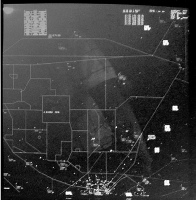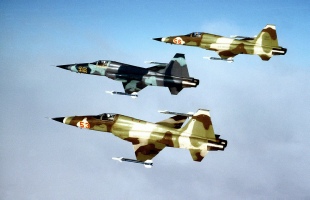


Red Flag ‘77 -
After every  sortie, all mission participants gathered for a comprehensive debrief led by the Red Flag directing staff, which included reports by each lead element involved and by the aggressors and ground-
sortie, all mission participants gathered for a comprehensive debrief led by the Red Flag directing staff, which included reports by each lead element involved and by the aggressors and ground-
The 208 Squadron contribution went down extremely well, The radio silence procedure caused doubt in some quarters as to whether the Squadron had actually been in the target area. Very few air kills had been claimed against the Squadron and the ground defenders on the EW (electronic warfare) ranges took great delight at leaving their control cabins to see some spectacular runs against their positions; they even produced video at the daily mass debrief of Buccaneers screaming past their radar heads to prove it. The Squadron crews used map, stopwatch and some major ‘mark one eyeball’ activity to navigate in the difficult desert terrain, which lacked pinpoint navigational fixes and gave little cover to the aircraft on fairly predictable target routes. Early spots, high speed and, when necessary, counter manoeuvring at ULL made the Buccaneers difficult targets for the aggressors to substantiate kills with their then weapons load.
The Squadron’s coordinated weapons attacks were also highly successful. The Buccaneer weapons system, which had been designed to toss a nuclear bomb against a Sverdlov cruiser, lacked much sophistication compared to modern digital computer- another quadrant, was another four in a simultaneous attack tossing from their planned point; all followed by an impressive inverted ‘Red Arrows’ bomb-
another quadrant, was another four in a simultaneous attack tossing from their planned point; all followed by an impressive inverted ‘Red Arrows’ bomb-
The F-






